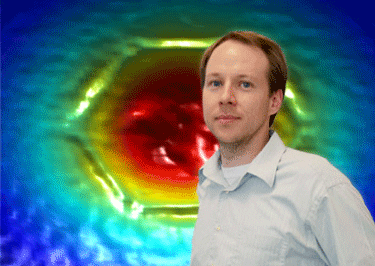
Better Models for Better Reactors
When engineers develop a complex new system, they typically compensate for a lack of field experience by overbuilding - extra material and heavy construction help create margin for error. This trend is seen in everyday life with airplanes, cars, and motorboats for example; over time, with more data and better computer-aided simulation and design, all have become lighter and more efficient, with better performance and improved safety.
Several NSE teams are bringing this type of evolution to nuclear reactors by developing more-accurate approaches to modeling of reactor behavior. A group led by Benoit Forget, current holder of the Norman K. Rasmussen Assistant Professorship, is working at the sub-atomic level, developing advanced mathematical analyses and computation tools that provide a clearer picture of the complex physics of reactor cores.
The fundamental work of a nuclear reactor is done by neutrons. These subatomic particles can cause an atom of uranium or other fissile material to split, and in turn release more neutrons that cause additional splitting, or fission.
In simplest terms, the basic challenge of reactor physics is to know the number of neutrons in a given space at a given time, their kinetic energy levels, and their direction of travel. With this knowledge, the resulting reactions (including fission) can be calculated and related to the amount of power generated at a given time in a given location. “The better we can analyze and understand what’s happening, the better the predictions we can make,” explains Forget.
Forget and his students are advancing the state of this art with innovative mathematical models of neutron transport that achieve new levels of fidelity and resolution. Some of the calculations push the limits even of today’s massively powerful computers, so Forget’s group is also working on novel computing approaches for processing subsets of the work in parallel.
The ultimate goal is to provide detailed information that enables reactor designers to achieve more power, better efficiency and well understood safety margins, without costly overbuilding.
The chair currently held by Forget was endowed by Institute alum Neil Rasmussen in honor of his late father, Norman Rasmussen, a pioneering and widely-admired NSE professor and department head and lead author of the WASH 1400 “Rasmussen Report.” This influential 1975 report for the Nuclear Regulatory Commission marked the first application of probabilistic risk assessment (PRA) to nuclear plant safety. Neil Rasmussen, holder of bachelor’s and master’s degrees from MIT’s EE program, co-founded American Power Conversion in 1981. After its acquisition by Schneider Electric in 2007, Rasmussen has continued his association with the company, and currently serves as Senior Vice President and Chief Innovation Officer of the combined firm.
“It was my father’s dream to see energy provided to the public without the impacts to our atmosphere that are associated with burning fossil fuels. Although he was primarily concerned with the threats of pollutant emissions and acid rain, recent concerns with global CO2 effects have made his vision more relevant than ever before” says Neil Rasmussen. “I am excited to support ongoing advancements in the field of reactor engineering, which may be one of the best tools we have for protecting our planet from the risks of global warming.”
The two-year Rasmussen professorship is a career development chair, designed to give younger faculty members an opportunity to establish their research activities and position themselves for future advances.
“It’s allowed me to start projects I wouldn’t have been able to get funded right away, and helped me push ideas for research grants that are more competitive. It’s really helping me establish myself in the field I want to work in,” says Forget, who is in his second year in the chair. “The funding also helps to support conference travel, and provide grants for students and equipment.”
“It was my father's dream to see energy provided to the public without the impacts to our atmosphere that are associated with burning fossil fuels. Although he was primarily concerned with the threats of pollutant emissions and acid rain, recent concerns with global CO2 effects have made his vision more relevant than ever before.”
—Neil Rasmussen
Written by Peter Dunn
Photo by Andrea Robles
